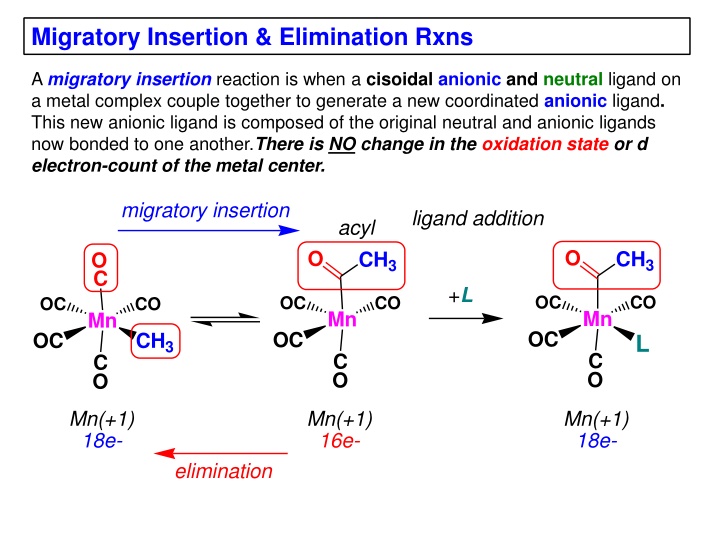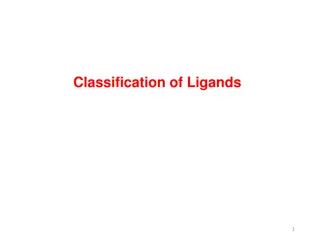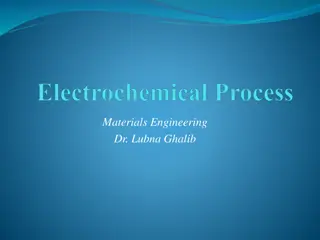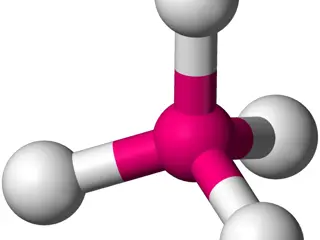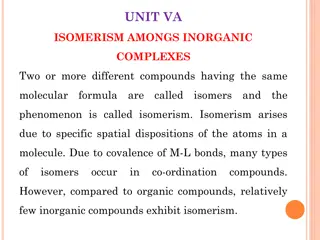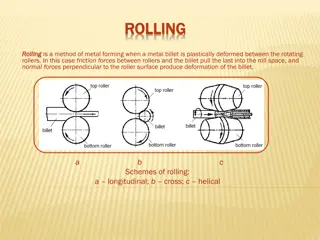Insights into Migratory Insertion and Elimination Reactions in Metal Complexes
Migratory insertion in metal complexes involves the coupling of a cisoidal anionic and neutral ligand to form a new coordinated anionic ligand without changing the metal center's oxidation state or d-electron count. This process requires cisoidality between the reacting ligands and a vacant coordination site for subsequent elimination reactions. Understanding the electronic effects, migration, and insertion processes is crucial for studying these reactions in metal complexes.
Download Presentation

Please find below an Image/Link to download the presentation.
The content on the website is provided AS IS for your information and personal use only. It may not be sold, licensed, or shared on other websites without obtaining consent from the author.If you encounter any issues during the download, it is possible that the publisher has removed the file from their server.
You are allowed to download the files provided on this website for personal or commercial use, subject to the condition that they are used lawfully. All files are the property of their respective owners.
The content on the website is provided AS IS for your information and personal use only. It may not be sold, licensed, or shared on other websites without obtaining consent from the author.
E N D
Presentation Transcript
Migratory Insertion & Elimination Rxns A migratory insertion reaction is when a cisoidal anionic and neutral ligand on a metal complex couple together to generate a new coordinated anionic ligand. This new anionic ligand is composed of the original neutral and anionic ligands now bonded to one another.There is NO change in the oxidation state or d electron-count of the metal center. migratory insertion ligand addition acyl O O CH3 CH3 O C +L OC CO OC CO OC CO Mn Mn Mn OC OC OC CH3 L C O C O C O Mn(+1) 18e- Mn(+1) 16e- Mn(+1) 18e- elimination
General Features of Migratory Insertions: 1) No change in formal oxidation state (exception: alkylidenes) 2) The two groups that react must be cisoidal to one another 3) A vacant coordination site is generated by the migratory insertion. Therefore, a vacant site is required for the back elimination reaction (e.g., -hydride elimination). A trapping ligand is often needed to coordinate to the empty site formed from a migratory insertion in order to stop the back elimination reaction. 4) Migratory insertions are usually favored on more electron-deficient metal centers. The following are common anionic and neutral ligands that can do migratory insertion reactions with one another: Anionic: H , R (alkyl), Ar (aryl), acyl , O2 (oxo) Neutral: CO, alkenes, alkynes, carbenes CO and alkyl migratory insertions (as shown on previous slide) are extremely important and are often generically referred to as carbonylation reactions. Hydride and CO migratory insertions to produce formyl groups are not common due to the thermodynamic instability of the formyl-metal interaction.
Some Electronic effects R O Z R Z O O C C + L O C Fe O C Fe L C O THF C O C O best Lewis acid - can coordinate to electron-rich CO ligands and drain off some e- density Z+ = Li+ > Na+ > (Ph3)2N+ strongest coordinating ligand - best trapping ligand L = PMe3 > PPhMe2 > PPh2Me > CO most electron-rich alkyl group makes the best nucleophile for migrating to the electron-deficient CO R = n-alkyl > PhCH2
Migration vs. Insertion Migration O O CH3 C a MIGRATION rxn involves the anionic ligand doing a nucleophillic-like attack on the neutral ligand. This involves the anionic ligand moving to the site where the neutral ligand is coordinated. An empty coordination site is left behind. OC CO OC CO Mn Mn OC CH3 OC C O C O Mn(+1) 18e- Mn(+1) 16e- Insertion O an INSERTION rxn involves the neutral ligand moving over to where the anionic ligand is coordinated and "inserting" into the anionic ligand-metal bond to generate the new anionic ligand. An empty coordination site is left behind from where the neutral ligand originally was located. C OC CO OC CO Mn Mn O OC CH3 OC C O C O CH3 Mn(+1) 18e- Mn(+1) 16e-
While most systems studied have been shown to do migrations, both are possible. The following is a system where both are very similar in energy and the solvent used favors one or the other. inversion Et migrates * * *CO Fe Fe * C Ph3P Ph3P CH3NO2 O Et Et * O O Fe Et Ph3P C O *CO HMPA * * Fe Fe O O Ph3P CO inserts Ph3P * C O Et Et retention
Alkene Migratory Insertions CH3 CH3 Zr Zr Zr CH3 CH3 Zr Zr CH3
Alkene Migratory Insertion -Hydride Elimination migratory insertion H + + H H H H H H H H H H H H H M H M M -hydride elimination * * * CO H CO R Nb Nb Nb R H R H * * * NMR irradiation of the Nb-hydride resonance affects the NMR resonance for the alkyl hydride, demonstrating that they are connected by the migratory insertion mechanism
Problem: Why dont either of the complexes shown below do alkene-hydride migratory insertions at room temperature? H Et3P Cl PPh3 Ir Pt Ph3P CO H PEt3 Problem: Sketch out and label the two mechanistic steps (in the correct order) that are occurring for the following reaction. Ru Ru + PPh3 H Ph3P C O C O
CH3 CH3 RCN PMe3 RCN PMe3 RCN PMe3 Rh Rh Rh Me3P H Me3P H Me3P CH3 O O O O Ph3P Ph3P O Ph3P -PPh3 O +PPh3 Pd Pd Pd Ph3P O Me Cl PPh3 Cl Cl Pd O Cl PPh3 Me
Agostic C-H to Metal Interactions Frozen Migratory Insertion * * * H H Co + H+ Co Co H H R3P R3P R3P One of the C-H bonds of the methyl group is within bonding distance to the Co center. This is called an Agostic C-H bond interaction. Because the C-H bond is sharing some of its -bond electron density with the metal, the C-H bond is weakened. This produces some relatively clear-cut spectroscopic characteristics: 1) C-H infrared stretching frequency is lowered to the mid-2500 cm 1 region from a normal value of 2900-3000 cm 1 2) the JC-H coupling constant in the 13C NMR is lowered to around 70-90 Hz from a normal value of 150 Hz. 3) the 1H chemical shift of the agostic proton is in the 10 to 15 ppm region, much like a metal-hydride resonance.
Carbene-Alkylidene Migratory Insertions X L X CH2 + L M M CH2 X = H , R , OR , halide Normally a migratory insertion refers to a neutral ligand reacting with an anionic ligand to produce a new anionic ligand. But if we electron-count the carbene as a dianionic ligand (alkylidene), we are reacting a monoanionic ligand (X) with a dianionic ligand (alkylidene) to make a new monoanionic ligand. This changes the oxidation state of the metal center and is now formally a reductive coupling reaction. In the case of X = H , the reverse reaction is called an -hydride abstraction or elimination.
Ph3C+ = good hydride abstracting reagent * * * + Ph3C+ Re Re Re H H3C H3C CH2 CH3 Ph3P Ph3P Ph3P * Re H Ph3P Ph3C NCMe Ph Ph NCMe W W W CH2 CH3 CH2 H Ph
Eliminations H H H -hydride elimination H M M H H -hydride elimination H M M R R O R carbonyl elimination or decarbonylation M M CO R The key points are: 1) No change in formal oxidation state (exception: alkylidenes) 2) You must have an empty orbital that is cisoidal to the group that you are doing an elimination reaction on. Alternatively, a cisoidal labile ligand that can easily dissociate to open up an empty orbital.
migratory insertion H + + H H H H H H H H H H H CH3 CH3 M CH3 M M But the reverse methyl elimination rxn is very difficult: methyl elimination H H H H H H H H H H Very Difficult! H H CH3 CH3 M CH3 M M rotation of C-C bond to move CH3 group away from metal to avoid steric effects CH3 H H H H H CH3 H H M M H -hydride elimination
One unusual example of what is believed to be a methyl elimination reaction is involved in the following transformation (Bergman, JACS, 2002, 124, 4192-4193): * * + HSiPh3 Rh + CH4 Rh N C Me3P Me3P C N H3C H3C CH3 SiPh3
* * * - NCCH3 + HSiPh3 - CH4 + NCCH3 Rh Rh Rh SiPh3 Me3P N Me3P Me3P N C H C Ph3Si H3C H3C CH3 CH3 Rh(+5) SiPh3 Rh N SiPh3 Rh C N Note that the isocyanide ligand is more strongly donating and a better -backbonding ligand than the starting acetonitrile. This keeps this from being a catalytic reaction. C CH3 H3C ligand dissociation methyl elimination * * * Rh Rh Rh N SiPh3 C Me3P Me3P Me3P C C CH3 N H3C N SiPh3 H3C Ph3Si
One reason that the methyl elimination reaction occurs here is that the -hydride elimination reaction generates a high energy ketene-imine: * * SiPh3 N Rh Rh N SiPh3 C Me3P Me3P C H2C H H3C
Problem: Identify each step in the following mechanism. Some steps may have several things occurring. 2 1 * * * Co Co Co H H3C H3C H3C H3C * CH2=CH2 PMe3 + CH4 + 3 Co Me3P
Problem: Sketch out a detailed mechanism and label each step for the following overall reaction. + 2CO Rh Rh Ph3P OC PPh3 CH3 H3C + O H3C CH3
